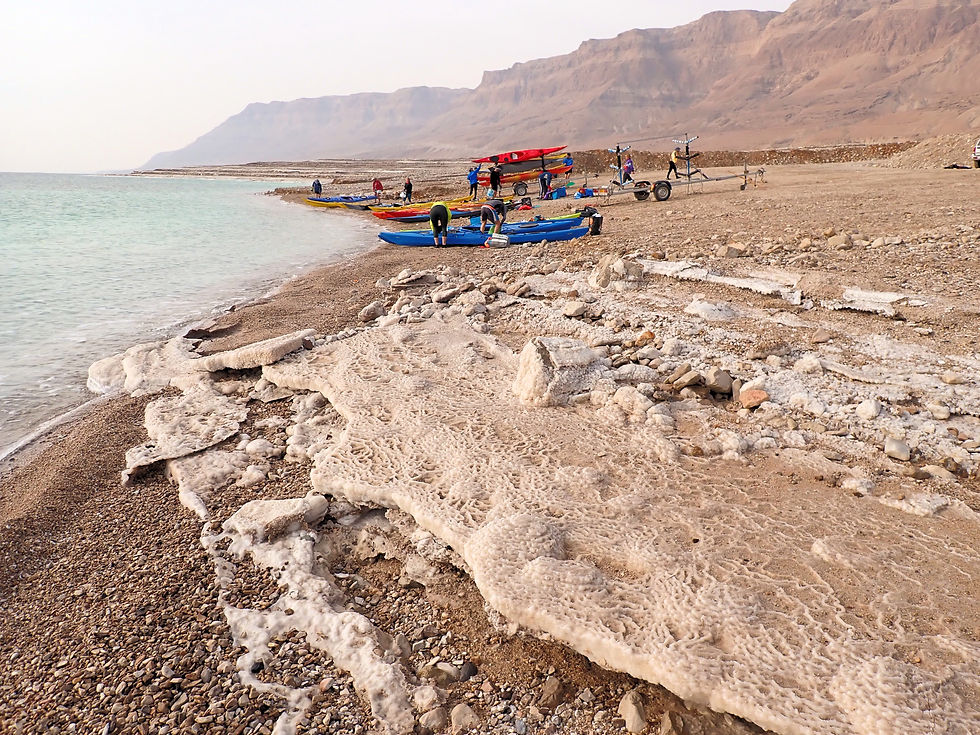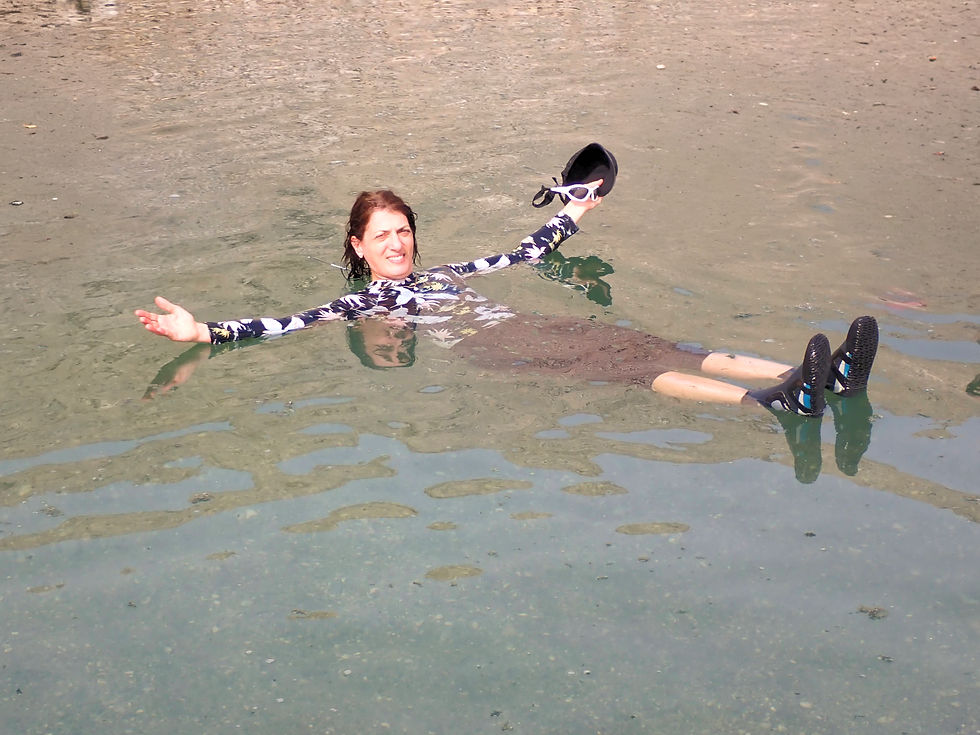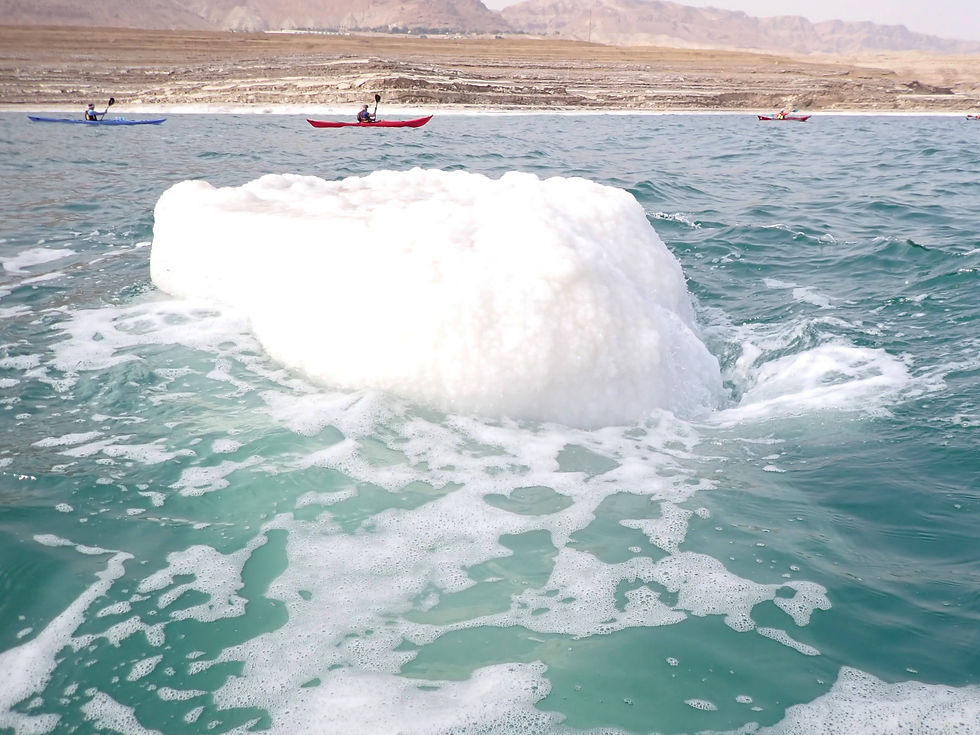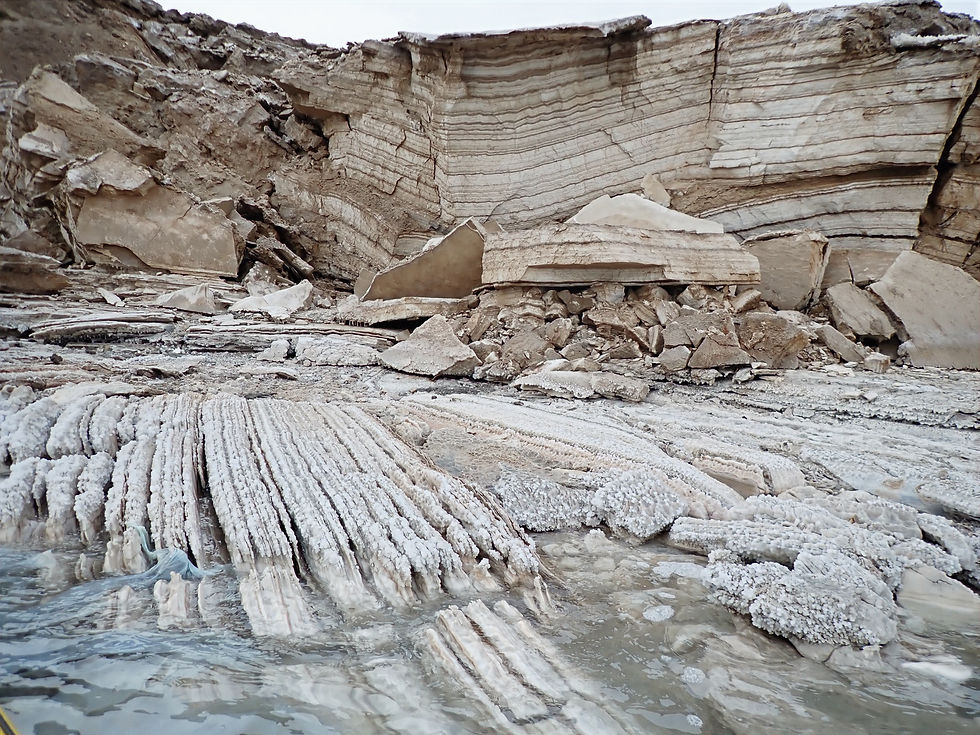Exploring the Mysteries of the Dead Sea: A Kayak Adventure
- Ruth Bergman

- Jan 14
- 4 min read
Updated: Mar 21
Kayak in the Dead Sea: is that a thing?
At home in Caesarea, Israel, we paddle with a kayak club called Optimist Kayak. Most years, if the weather and security situation allow, the club organizes a trip to the Dead Sea. This incredible destination is the lowest place on Earth, over 400 meters below sea level. Although I have visited the Dead Sea many times, exploring this unique ecosystem by kayak was a new and unexpected experience that filled me with excitement. Equipped with my paddle and waterproof camera, here's how our unforgettable day unfolded and the wonders we encountered.
In the morning, we loaded the kayaks at the club and made the two-hour drive to the Dead Sea. Once our kayaks were set up, we received a quick orientation on the differences of paddling in the Dead Sea's salty, buoyant waters. A local guide from one of the area kibbutzim advised us to apply sunscreen carefully to prevent it from running into our eyes, as we would inevitably rub them with salty hands. We then eagerly set off towards one of nature's most remarkable wonders.
The Geography of the Dead Sea: The Lowest Place on Earth
The Dead Sea, located in the Jordan Rift Valley, is one of the most remarkable geographical features on Earth. Straddling the borders of Jordan to the east and Israel and the West Bank to the west, it is the lowest point on the planet, sitting at approximately 430 meters (1,410 feet) below sea level. This region is geologically significant, lying along a tectonic plate boundary that shapes its basin and contributes to its dynamic environment. This hypersaline lake is renowned for its extremely high salt concentration, which prevents most life forms from thriving—hence its name. Surrounded by desert landscapes, the Dead Sea is fed mainly by the Jordan River and has no outlet, leading to intense evaporation that contributes to its unique salinity.
We set off from a northern beach of the Dead Sea, far from the usual tourist spots. With striking desert cliffs at our back and salt deposits lining the beach, we realized we were in for a unique adventure.

Floating in the Dead Sea
Floating in the Dead Sea is a rite of passage for anyone visiting. This fascinating phenomenon is caused by its incredibly high salt concentration, which dramatically increases the water's density. The Dead Sea's salinity is about 10 times higher than that of typical seawater, containing around 34% dissolved salts and minerals. This density makes the water much heavier than the human body.
Floating in the Dead Sea is a unique and enjoyable experience, as long as you take a few precautions. Just remember to avoid swallowing the water or getting it in your eyes—those are the key rules to follow. It’s quite astonishing to think that, despite its high buoyancy, people have drowned in this sea. But fear not! With a little care, you can fully embrace the soothing sensation of floating.

Hot Springs and Minerals of the Dead Sea
The Dead Sea is also renowned for its natural hot springs, which attract visitors seeking relaxation and therapeutic benefits. The mineral-rich waters of these springs are believed to alleviate various ailments, including skin conditions and joint pain. The warm temperatures combined with the mineral content create a soothing environment that promotes healing and rejuvenation. Many wellness resorts and spas in the region offer treatments that incorporate these natural hot springs.
The extraction of potassium salts has become a significant industry for Israel, contributing to its economy. If you have been to Israel, or any mall in the US, you would have encountered creams boasting Dead Sea minerals.
Our paddling group stayed away from the busy resorts and took a break at a secluded beach, accessible only from the water, with hot springs and mineral rich soil.

Dead Sea Microbiotic Life
As you stroll along the Dead Sea's shore, you won't come across seaweed or seashells. These typical plants and animals cannot survive in the water's high salinity. Although many believe the Dead Sea is devoid of life, I discovered on this trip that it is full of unique microscopic organisms that have adapted to these challenging conditions. On our kayaking tour, It was fascinating to see the structures constructed due to these microorganisms lifecycle.

Dead Sea Erosion and Environmental Changes
As beautiful as the Dead Sea is, it faces serious environmental challenges. Water levels are dropping—by approximately one meter each year—primarily due to the diversion of inflowing rivers and mineral extraction.
This decline is alarming because it jeopardizes the geography and ecology of this region. These layers of deposited minerals that have been buried under water are now standing exposed. Sink holes have become commonplace. Standing at the shoreline, I pondered the need to protect this natural wonder for future generations.

Visit While You Can
Even though I have visited the Dead Sea numerous times, I now perceive it differently. Previously, I saw it as a sea for bathing, with the bonus of floating. I marveled at the sign indicating you are below sea level. Now, I view it as something precious, akin to melting Arctic glaciers, a place that is eroding each year and day, a wonder to admire and protect.
In a constantly changing world, locations like the Dead Sea remind us of nature's magnificence and our connection to it. I encourage you to kayak the Dead Sea and immerse yourself in its mysteries. It is an experience that will leave a lasting impression on your heart.



Comments